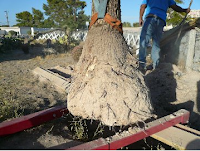 |
Dog urine damage. You can tell because it is darker
green around the dead spot due to the extra nitrogen
in the urine. |
Q. I have some grass in my backyard. I installed sod when I first moved to this house and 7 years of having two dogs and three kids have done its damage. I have large patches of dead spots and the live spots are not looking so good either. Haha. The problem with reseeding or sodding is that one of my dogs is still 7 months old and would tear it up as it happens. I was thinking of getting some Zoysia grass or something like that. What brands do you think do well here? My other option is artificial grass and that is a bit pricey right now.
A. If dogs or a dog is tough on your lawn then there isnt much you can do about keeping a lawn looking good. Even zoysia grass, as tough as it is, will have problems with dogs and kids who play outside alot and roughhouse.
 |
| El Toro zoysiagrass |
Artificial grass has its drawbacks. Number one are the temperatures it can generate even on a moderately warm 95F day. Surface temperatures of artificial grass can climb to well over 150F on a modestly warm day, midday in full sun. Artificial grasses need to be kept clean since small surface debris does not decompose as it does in a lawn.
If you do elect to use artificial grass make sure it is in the shade. If you elect to use a natural grass you might want to consider Kentucky 31 tall fescue. I normally do not recommend this grass for most lawns because of its coarse texture. It is not a pretty grass to look at but it is tougher than just about any other cool season grass. It can be reseeded easily in spring and fall months. But it is a water hog.
Try rotating your pet into different parts of the lawn at different times so that grass which has been beat up pretty bad has a few weeks to recuperate before fido is let on that patch again. When fido has been rotated off of a patch then fertilize it, aerate it and push some new growth to get it to recover as fast as it can.

















